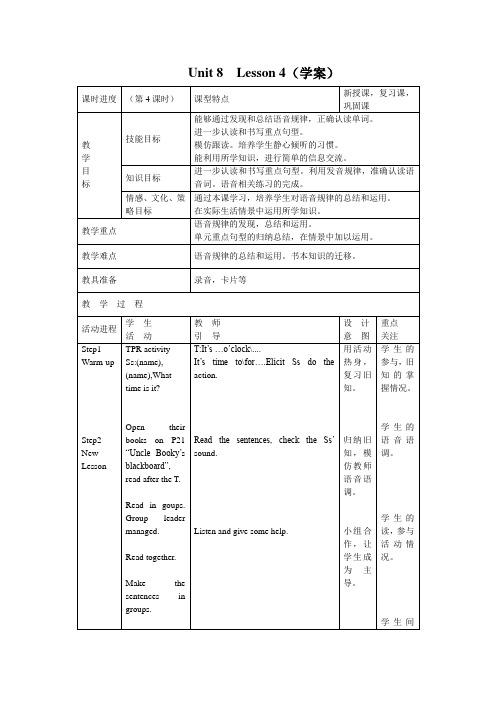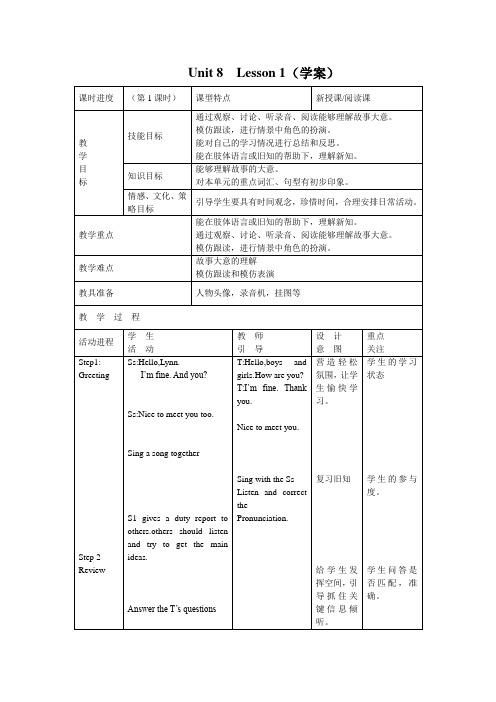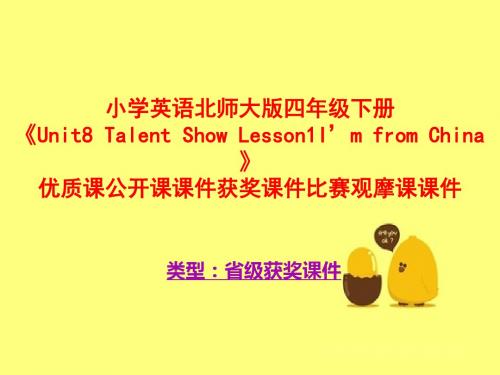北师大四年级 Unit8 Talent Show
- 格式:ppt
- 大小:7.00 MB
- 文档页数:34
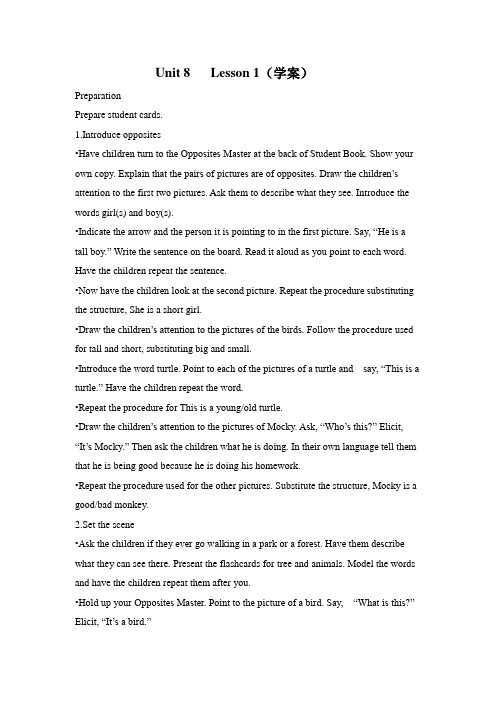
Unit 8 Lesson 1(学案)PreparationPrepare student cards.1.Introduce opposites•Have children turn to the Opposites Master at the back of Student Book. Show your own copy. Explain that the pairs of pictures are of opposites. Draw the children’s attention to the first two pictures. Ask them to describe what they see. Introduce the words girl(s) and boy(s).•Indicate the arrow and the person it is pointing to in the first picture. Say, “He is a tall boy.” Write the sentence on the board. Read it aloud as you point to each word. Have the children repeat the sentence.•Now have the children look at the second picture. Repeat the procedure substituting the structure, She is a short girl.•Draw the children’s attention to the pictures of the birds. Follow the proc edure used for tall and short, substituting big and small.•Introduce the word turtle. Point to each of the pictures of a turtle and say, “This is a turtle.” Have the children repeat the word.•Repeat the procedure for This is a young/old turtle.•Draw the children’s attention to the pictures of Mocky. Ask, “Who’s this?” Elicit, “It’s Mocky.” Then ask the children what he is doing. In their own language tell them that he is being good because he is doing his homework.•Repeat the procedure used for the oth er pictures. Substitute the structure, Mocky is a good/bad monkey.2.Set the scene•Ask the children if they ever go walking in a park or a forest. Have them describe what they can see there. Present the flashcards for tree and animals. Model the words and have the children repeat them after you.•Hold up your Opposites Master. Point to the picture of a bird. Say, “What is this?” Elicit, “It’s a bird.”•Repeat for turtle. Write turtle on the board and have the children repeat the word after you.•Ask the children how they would feel walking in the forest. Try to elicit “happy” in their own language. Present the English word, happy. Write it on the board. You could also draw a smiling face.3.Model the dialog•Using the Opposites Master, review the structure, “He is a tall boy.”Have the children repeat the sentence.•Use the same picture to present the structure, “He’s not a short boy.” Have the children repeat the sentence.•Repeat the procedure for the other pictures.4.Talk about the storyStudent Book pages 14 and 15Have the children open their books at pages 14 and 15.Ask these questions about the pictures:Picture 1: .“Where are Ken, Ann, and Mocky?”Picture 2:.“What are they looking at?”Picture 3: .“Who is Mocky talking to?”Pictures 4/5: .“What do you think Mocky is saying?”Pictures 6/7: .“What are Ann and Mocky looking at?”Picture 8: “What do you think Ann is saying?”“What is Mocky’s answer?”Pictures 9/10:“What is happening now?”5.StoryStudent Book pages 14 and 15•Say, “Now we will hear what the characters said.” Play the tape and have the children look at the pictures as they listen.•Play the tape again, pausing at each picture. Have the children repeat the words each time.6.Set homeworkExplain that you want them to color the pictures on Opposites Master and bring them to the next lesson.。
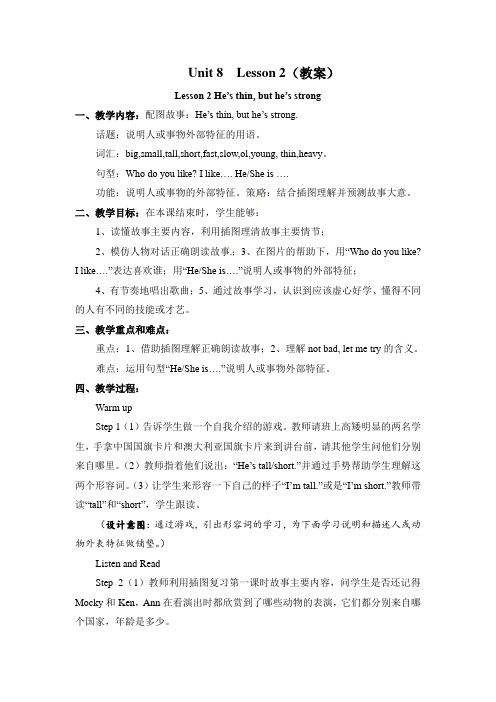
Unit 8 Lesson 2(教案)Lesson 2 He’s thin, but he’s strong一、教学内容:配图故事:He’s thin, but he’s strong.话题:说明人或事物外部特征的用语。
词汇:big,small,tall,short,fast,slow,ol,young, thin,heavy。
句型:Who do you like? I like…. He/She is ….功能:说明人或事物的外部特征。
策略:结合插图理解并预测故事大意。
二、教学目标:在本课结束时,学生能够:1、读懂故事主要内容,利用插图理清故事主要情节;2、模仿人物对话正确朗读故事;3、在图片的帮助下,用“Who do you like?I like….”表达喜欢谁;用“He/She is….”说明人或事物的外部特征;4、有节奏地唱出歌曲;5、通过故事学习,认识到应该虚心好学、懂得不同的人有不同的技能或才艺。
三、教学重点和难点:重点:1、借助插图理解正确朗读故事;2、理解not bad, let me try的含义。
难点:运用句型“He/She is….”说明人或事物外部特征。
四、教学过程:Warm upStep 1(1)告诉学生做一个自我介绍的游戏。
教师请班上高矮明显的两名学生,手拿中国国旗卡片和澳大利亚国旗卡片来到讲台前,请其他学生问他们分别来自哪里。
(2)教师指着他们说出:“He’s tall/short.”并通过手势帮助学生理解这两个形容词。
(3)让学生来形容一下自己的样子“I’m tall.”或是“I’m short.”教师带读“tall”和“short”,学生跟读。
(设计意图:通过游戏,引出形容词的学习,为下面学习说明和描述人或动物外表特征做铺垫。
)Listen and ReadStep 2(1)教师利用插图复习第一课时故事主要内容,问学生是否还记得Mocky和Ken,Ann在看演出时都欣赏到了哪些动物的表演,它们都分别来自哪个国家,年龄是多少。
